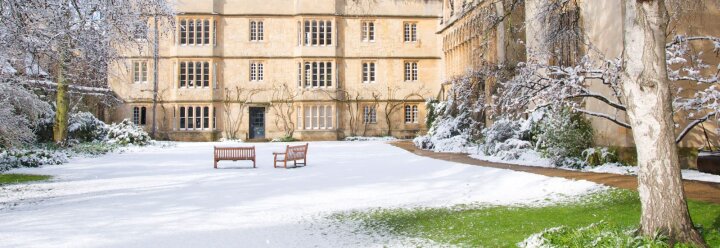Earth Sciences at Exeter College

Facilities include an extensive library (open 24/7 during term), on-site gym, stunning dining hall, cosy bar, chapel, music practice rooms, performance space, learning space and sports ground. We have a beautiful garden, with views over Radcliffe Square. Exeter is home to a wide range of student groups, clubs and societies, including our excellent student-led choir, music, theatre and sports teams.

Our Research in the Palaeomagnetism and Rock Magnetism Group at the University of Oxford addresses a broad spectrum of the Earth Sciences. The laboratory was set up in the Department of Earth Sciences in 1986, and its personnel have taken a leading role in the development of new applications of the palaeomagnetic technique to solving problems in diverse areas of geology and environmental change. Current projects involve members of the Departments of Earth Sciences, Geography, as well as many UK and internationally based collaborators from diverse disciplines within academia and the commercial sector. We work in particularly close collaboration with researchers in tectonics and structural geology, sedimentology and stratigraphy, volcanology, archaeology, geodynamics, and isotope geochemistry.
We use numerical models, mathematical theory and analysis of data to study the ocean’s carbon cycle and its interaction with physical circulation and climate. Our research ranges from exploiting observations to quantify the absorption of human CO2 emissions by the ocean to developing novel computational approaches to simulating ocean biogeochemical cycles.
Current research projects include:
Transient tracer-based Investigation of Circulation and Thermal Ocean Change (TICTOC)
Biological carbon pump Assessment using the Transport Matrix method and global Nutrient distributions (BATMAN)
Controls over Ocean Mesopelagic Interior Carbon Storage (COMICS)
Transport Matrix Method (TMM)
Assessing Climate Model Simulations of Last Glacial Maximum Ocean Circulation with Carbon Isotopes
Constraining the Past and Future Ocean Sink of Anthropogenic Carbon with Observations
We are an active group interested in the structure and evolution of the world’s ocean basins and their margins. To date, we have participated in 14 research cruises on the RRS Charles Darwin, RRS James Clark Ross, RRS Discovery, RRS James Cook, MV Meteor, MV SONNE, MV Marion Defresne, MV GECO Prakla, MV Hawk Explorer and MV Marcus G. Langseth. The cruises, which have been collaborative efforts with scientists from the Universities of Birmingham and Durham, the National Oceanography Centre, the British Antarctic Survey, the Institute of Earth Sciences in Barcelona, IFM-GEOMAR in Kiel, the Petroleum Institute in Abu Dhabi and the Lamont-Doherty Earth Observatory in New York, and have been involved in field work offshore Gibraltar, Spain, Morocco, Canary Islands, Cape Verde Islands, French Guiana, Brazil, Surinam, United Arab Emirates, South Africa and Antarctica (South-West Indian Ocean Ridge), Australia and New Zealand, Tonga Islands, Fiji and Hawaii. The cruise data have been the subject of more than 11 Ph.D and Masters theses and several publications.
The group maintains a network of DELL Quod Core workstations and has access to Globe Claritas, Geosoft Montaj, GeoMapApp, GMT, Seismic Unix, rayinvr and MB software for the processing and display of underway marine geological and geophysical data and an ‘in house’ software system for gravity, flexure, subsidence and uplift and stratigraphic modelling of elastic and viscoelastic plates using 2D and 3D forward and inverse techniques




